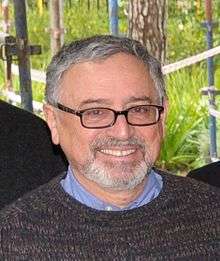Lev R. Ginzburg
| Lev R. Ginzburg | |
|---|---|
 | |
| Born |
January 11, 1945 Moscow, Russia |
| Residence | Old Field, New York and Manhattan, New York |
| Nationality | USA |
| Fields |
|
| Institutions | |
| Alma mater | Leningrad State University |
| Known for |
|
Lev R. Ginzburg (Russian: Лев Рувимович Гинзбург; born 1945) is the President of Applied Biomathematics and a mathematical ecologist.
Biography
Lev Ginzburg was born in 1945 in Moscow, Russia, but grew up in St. Petersburg, at the time Leningrad. He studied mathematics and theoretical mechanics at Leningrad State University (M.S. in 1967) and received his Ph.D. in applied mathematics from the Agrophysical Research Institute in 1970. He worked at this Institute until his emigration to the United States in 1975. After a few months at the Accademia Nazionale Dei Lincei (Rome, Italy), and one year at the Mathematics Department at Northeastern University (Boston, MA), he was a professor at the Department of Ecology and Evolution at Stony Brook University (Stony Brook, New York 1977-2015).[1] Since 1982, Dr. Ginzburg has run Applied Biomathematics, a research and software firm focused on conservation biology, ecology, health, engineering and education. The company develops new methods for the assessment of risk and uncertainty in these areas.[2] RAMAS software is used by thousands of people in over 60 countries.
Work
Dr. Ginzburg founded Applied Biomathematics in 1982. Applied Biomathematics is a research and software firm focused on ecology, health, and engineering. The company is funded primarily by research grants and contracts from the U.S. government and private industry associations. Grants include awards from the National Institutes of Health, United States Department of Agriculture, NASA, National Science Foundation, and the Nuclear Regulatory Commission. Other project funding has come from the Electric Power Research Institute[3] and individual utility companies, healthcare, pharmaceutical and seed companies such as Pfizer, DuPont and Dow, and the U.S. Army Corps of Engineers.[4] Applied Biomathematics translates theoretical concepts from biology and the physical sciences into new mathematical and statistical methods to quantitatively solve practical problems in these areas using risk analysis and reliability assessments.[5] The methods and RAMAS software products developed by Applied Biomathematics are used by hundreds of academic institutions around the world, government agencies, and industrial and private labs.[6] Dr. Ginzburg's work in risk analysis and applied ecology has been conducted at Applied Biomathematics in collaboration with Dr. Scott Ferson and Dr. Resit Akcakaya, who are now professors, respectively, at the University of Liverpool, UK, and Stony Brook University, New York, USA.
Dr. Ginzburg’s most known academic work is a theory of predation (the ratio-dependent or Arditi-Ginzburg model) that is an alternative to the classic prey-dependent Lotka-Volterra and MacArthur-Rosenzweig models.[7] His book, with Roger Arditi, How Species Interact summarizes their proposed alteration of the standard view.[8] Next in recognition has been inertial growth or an explanation of population cycles, based upon maternal effect model, the main point of the book Ecological Orbits[9] and a more recent paper.[10] One of Dr. Ginzburg’s current interests is in the field of metabolic ecology. His work centers on the idea that generation time is an essential fourth dimension of an organism (in addition to the dimensions of space that it occupies).[11] He also works on an evolutionary theory of non-adaptive selection (selective disappearance of unstable configurations).[12][13] A book in progress (Non-Adaptive Selection, joint with John Damuth) relates to this area of research.[14]
Selected Publications
Ginzburg has published over 150 scientific articles and nine books.
References
- ↑ "About". Life.bio.sunysb.edu. Retrieved 2013-09-09.
- ↑ "RAMAS Software by Applied Biomathematics". Ramas.com. Retrieved 2013-09-09.
- ↑ Miller, M. (2003). Eco-Asset Management: Banking on Nature’s Fortune, Palo Alto, California, page 25
- ↑ Research by Applied Biomathematics
- ↑ RAMAS: Technical software that anyone can use
- ↑ Applied Biomathematics' Research Strengths
- ↑ Arditi, R.; Ginzburg, L.R. (1989). "Coupling in predator-prey dynamics: ratio dependence". Journal of Theoretical Biology (139): 311–326.
- ↑ Arditi, R. and Ginzburg, L.R. 2012. How Species Interact: Altering the Standard View on Trophic Ecology. Oxford University Press, New York, NY.
- ↑ Ginzburg, L.R.' and Colyvan, M. 2004. Ecological Orbits: How Planets Move and Populations Grow. Oxford University Press, New York, NY.
- ↑ Ginzburg, L; Krebs, C (2015). "Mammalian cycles: internally defined periods and interaction driven amplitudes". PeerJ. 3: e1180. doi:10.7717/peerj.1180.
- ↑ Ginzburg, L.R; Damuth, J. (2008). "The space-lifetime hypothesis: viewing organisms in four dimension, literally". American Naturalist. 171: 125–131. doi:10.1086/523947.
- ↑ Ginzburg, L.R.; Burger, O.; Damuth, J. (2010). "The May threshold and life history allometry". Biology Letters. 6: 850–853. doi:10.1098/rsbl.2010.0452.
- ↑ Borrelli, J.; Allesina, S.; Arditi, R.; Chase, I.; Damuth, J.; Holt, R.; Logofet, D.; Rohr, R.; Rossberg, A.; Spencer, M.; Tran, K.; Ginzburg, L.R. (2015). "Selection on stability across ecological scales". Trends in Ecology and Evolution. 30 (7): 417–425. doi:10.1016/j.tree.2015.05.001.
- ↑ "Books & Book Reviews". Life.bio.sunysb.edu. Retrieved 2013-09-09.